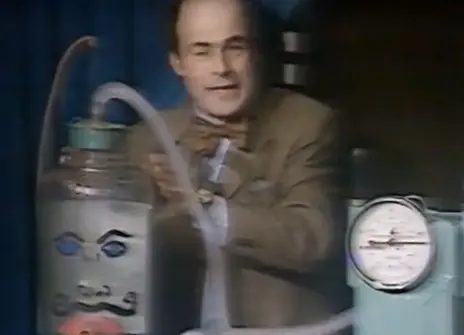Lecture 1 – You as an engine
From the 1975 programme notes:
The body can be regarded as a rather special internal combustion engine, insofar as its ability to perform mechanical work is concerned. Some of this work is expended to keep it alive, for instance by pumping the blood around and breathing, whilst the rest appears as an external activity. Walking, running and lifting sacks of coal all involve the expenditure of energy which ultimately has to be derived from the fuel, i.e. the food supplied to the body. Just as in a car engine, not all the energy contained in food can be converted into mechanical work; at best only about 20% appears as work, the rest being converted into heat.
There are many occasions when one wants to measure how hard an individual is working or more correctly how much energy he is consuming. This is important in fields as diverse as the organisation of some industrial production processes in order to minimise the load on the worker, and the investigation of the factors causing obesity.
In a petrol engine, we could measure the rate at which fuel is being consumed quite easily but in man it is impossible to measure fuel consumption directly, because our bodies contain large and variable energy stores on which we draw to supply our immediate needs.
However, we cannot store any substantial amounts of the oxygen which is required to 'burn' the fuel, and if therefore we were to measure the amount of oxygen removed from the inspired air this would provide an indirect but convenient method of measuring energy expenditure. This procedure is known as 'indirect calorimetry' and is performed these days by using interesting and complex physical methods of air flow measurement and gas analysis. We will endeavour to measure the efficiency of the human engine and compare it with that of a small petrol driven generator.
About the 1975 CHRISTMAS LECTURES
In his 1975 CHRISTMAS LECTURES, Heinz Wolff explores how to investigate your inside without breaking the skin.
From the 1975 programme notes:
Imagine that you had to find out what was wrong with a motor car, but that you were not allowed to open the bonnet, or undo any nuts and bolts, or to break any wires. You would have to rely entirely on the noises you could hear, on how it reacted to the manipulation of external controls, and maybe on the characteristics of the exhaust.
The doctor using only his own senses is in much the same position when examining a patient, except that he has to deal with a very much more complicated system, and moreover one which is understood less completely than a motor car. This series of lectures is about how one can examine the functioning or the structure of the inside of the body noninvasively, that is, without having to open the patient. In particular, they will be concerned with the techniques which are now available to amplify the doctor's senses or to detect signals to which we are normally quite insensitive.
Each lecture will take a particular set of signals, consider their origin and why they are important, demonstrate how they are detected and measured, and explain how the instrumentation works. The lectures will also illustrate how much modern medicine is becoming dependent on a proper application and understanding of engineering and physical principles.






